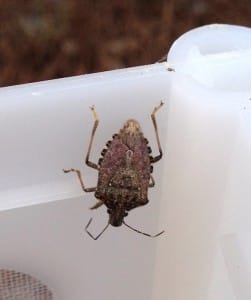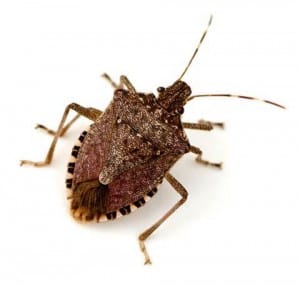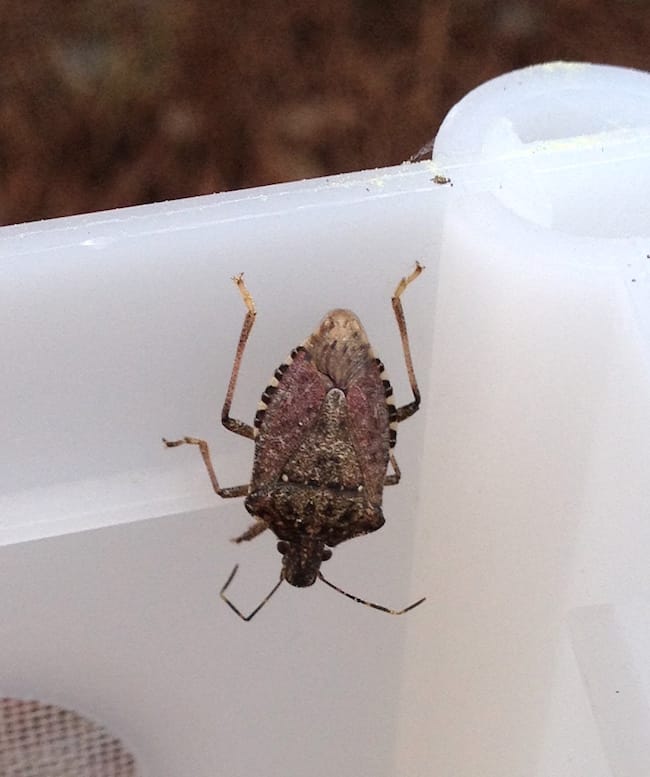
Sharon Dowdy, news editor with the UGA College of Agricultural and Environmental Sciences
Edited from a longer article. You can find it here.
A University of Georgia entomologist is asking Georgians to help track an insect that loves to stowaway in homes and has the potential to hurt the state’s crops.
The brown marmorated stink bug, a native of Asia, was first spotted in Allentown, Pennsylvania, in 1998 and has since been found in 42 states and two Canadian provinces, according to the U.S. Department of Agriculture. To date, it is classified as a nuisance pest in Georgia, but could quickly become an agricultural pest, too.
Paul Guillebeau, an entomologist with the UGA College of Agricultural and Environmental Sciences, decided to find out how many Georgians are unwillingly hosting the pest. He thought of the project after lying in bed at night and counting the number of stink bugs crawling on his Athens, Georgia, ceiling. “On any given day, there are at least five or six on the ceiling and at least 20 throughout the rest of the house,” he said. “You could spray them, but then you’d have dead stink bugs to deal with. It really becomes tedious. They only stink if you handle them, and they don’t do any damage, but they are annoying.”
He thought of the project after lying in bed at night and counting the number of stink bugs crawling on his Athens, Georgia, ceiling. “On any given day, there are at least five or six on the ceiling and at least 20 throughout the rest of the house,” he said. “You could spray them, but then you’d have dead stink bugs to deal with. It really becomes tedious. They only stink if you handle them, and they don’t do any damage, but they are annoying.”
Guillebeau likens the pest to lady beetles and kudzu bugs, which also torment homeowners by slipping through the tiniest crack to find a warm spot indoors. The stink bugs are first attracted to light and then to the warmer, indoor temperatures.
“I think my house is fairly well sealed, but they are awfully good at getting inside,” he said.
As temperatures begin to rise, the bugs are coming out of their winter slumber and searching for food and water. “Now they are flying to the windows, searching for a way to get out,” he said.
Once the brown marmorated stink bugs return to the outdoors, UGA entomologist Kris Braman hopes home gardeners will take a close, identifying look before killing them.
“The brown marmorated stink bug damages a host of plants, from ornamentals to trees to food crops,” she said. “But there are many other look-alike stink bugs and some of these are predators (that feed on harmful garden pests).”
Brown marmorated stink bugs have striped antennae, smooth shoulders and small mouthparts. Beneficial, predator stink bugs have solid antennae, spines or indentations on their shoulders and a “much stouter” mouth.
“You may need a hand lens to get a close look, but it will be worth it because they eat harmful garden insects like the Mexican bean beetle,” Braman said.
To participated in Guillebeau’s tracking survey, go to www.surveymonkey.com/s/FCLPJLX. The three-question survey will remain open until responses begin to dwindle and the state has been represented.
“I think they are everywhere across the state, but we will just have to wait and see,” Guillebeau said. “I just hope of one of my colleagues develops a trap to catch them before they come in my house next year.”
For help identifying the Brown marmorated stink bug see this article.
This video contains more information on the stinkbug.
Find more information on beneficial insects on page 28 of the publication Insect Identification Guide for Southeastern Landscapes.
